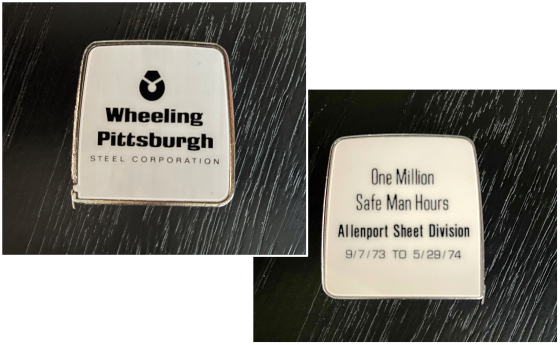Final Thoughts

Final Thoughts
Written by David Schollaert
September 15, 2022
Since this is my first time officially tackling Final Thoughts, I figured what better time than now to take a few moments and formally introduce myself.
Even though you’ve been reading Premium and Executive content that I’ve authored here for SMU for a little over two years, my experience in the metals and mining industry—primarily steelmaking raw materials (ferroalloys)—formally started in 2009.
![]() But I guess you could say that my genesis in the steel industry dates back to the spring of 1953. No, bahaha, it’s not another ‘Benjamin Button’ case, that’s when my grandfather, Frank J. Schollaert, a graduate of Belmar High School started working at Pittsburgh Steel’s Allenport Works in Pennsylvania at the ripe old age of 17.
But I guess you could say that my genesis in the steel industry dates back to the spring of 1953. No, bahaha, it’s not another ‘Benjamin Button’ case, that’s when my grandfather, Frank J. Schollaert, a graduate of Belmar High School started working at Pittsburgh Steel’s Allenport Works in Pennsylvania at the ripe old age of 17.
Pittsburgh Steel would later merge with Wheeling Steel in 1968, becoming Wheeling-Pittsburgh Steel Corp. My grandfather would go on to work his way up through the ranks until his retirement in 1983, just before the steelmaker would file for bankruptcy protection due to labor contract disagreements and a pension crisis.
It also didn’t hurt that the company was slow to modernize its high-cost facilities, accumulating excess debt following a series of modernization programs in the 1960s and 1970s. The steelmaker was just one of the sad stories of the state of the US steel industry in the 1970s and early 1980s.
But I digress…
This is all very fresh in my mind because my grandfather passed away this past November and my family has been going through a treasure trove of keepsakes from his life, a life well-lived.
Earlier this week, my dad handed me a priceless souvenir he had recently ‘unearthed’, a mint-condition (photo below) commemorative tape measure from Wheeling-Pittsburgh Steel my grandfather received in 1974. The occasion? Celebrating “One Million Safe Man-Hours” at the Allenport Sheet Division—from Sept. 7, 1973 to May 29, 1974.

My second connection to steel relates to my upbringing. No, my dad was not a second-generation steelworker, thus potentially paving my way into the industry, but rather a missionary. Growing up—raised for nearly 18 years—I had the privilege of living in Belo Horizonte, the state capital of Minas Gerais, and Brazil’s ‘mining capital.’ The state presently has the country’s largest iron ore reserves and three of Brazil’s largest iron ore mines.
Steel has been directly and indirectly a part of my life and little did I know that my linguistic skills (native Portuguese and Spanish speaker thanks to my upbringing) would open the door to a fulfilling career in the mining and metals industry. One that began when my wife and I moved to Pittsburgh for a change of scenery nearly a decade and a half ago.
It also unlocked a priceless cache of dialog with my grandfather I now had after spending the first 26 years of my life thousands of miles away.
Now back to my grandfather’s memento. Granted, “one-million safe man-hours”, though a significant accomplishment, pales in comparison to some of the safety records we see today. And that could be argued is largely due to the modernization the steel industry has undertaken over the past 40-plus years.
Technological advancements have made production more efficient, and several jobs have been replaced in favor of automation. Since 1960, American steel mills have decreased from an average of 700,000 workers to just 83,000. And within the last 40 years, the productivity of labor has increased more than five times from approximately 10 man-hours per finished ton to under two.
This leads me to the latest status of the industry’s labor talks and today’s final thoughts.
Labor is no longer a major cost burden to mills. Today’s labor accounts for roughly 10% of mill costs and will soon likely be even less. So why such tension with some of the recent labor talks, especially in particular the apparent stalemate between US Steel Corp. (USS) and the United Steelworkers (USW)?
The USW was able to swiftly agree to new labor pacts with Cleveland-Cliffs’ steelmaking and mining operations over the past few weeks. In Canada, the USW has ratified agreements with both Algoma and Stelco, though not after some contentious moments and threats of strikes.
Unrelated but of note, a nationwide railroad strike was averted today with a tentative labor agreement reached earlier this morning.
But back to the current labor agreement impasse.
We’ve covered extensively the steelmaker’s redirection of investments away from its union-represented Mon Valley Works near Pittsburgh to Big River Steel, its non-union EAF sheet mill in Arkansas. And not only does it seem that US Steel is unwilling to match what it sees as the more favorable terms provided by Cliffs, but rumors of an extended idling of USS’s No. 3 blast furnace post-maintenance have not been squashed by the steelmaker.
US Steel confirmed it idled three additional furnaces in response to weak demand in its earnings guidance figures released this morning, Sept. 15. Not to mention the steelmaker confirmed to SMU that it has idled the No. 8 blast furnace at Gary Works in Gary, Ind., due to poor market conditions.
Is this deadlock between US Steel and the USW a preamble to something more permanent or severe? The potential closure of Mon Valley Works Edgar Thompson plant partially or all?
Is the union’s strong position an effort to stave off what some suggest may be the writing on the wall?
Would an unwilling union “force” the steelmaker to lockout its USW workforce, close operations at Mon Valley’s higher-cost, less-efficient blast furnace, and shift its focus to its more-efficient EAF-steelmaking operations at Big River Steel Works?
It’s impossible to know what’s next. But one must wonder, after a historic run that saw American steelmakers report record-breaking results quarter after quarter for two-plus years, are unions asking for too much or just trying to share in the abundance?
By David Schollaert, David@SteelMarketUpdate.com

David Schollaert
Read more from David SchollaertLatest in Final Thoughts

Final Thoughts
The difference: The spat with Turkey was a big deal for steel. This time, the 50% reciprocal tariff for Brazil – if it goes into effect as threatened on Aug.1 – hits everything from coffee and to pig iron. It seems almost custom-built to inflict as much pain as possible on Brazil.

Final Thoughts
Are we on the cusp of sorting out the tariff situation, or is this merely another round in the bout?

Final Thoughts
I’m not sure how many different ways I can write that it’s been a quiet market ahead of Independence Day. There are variations on that theme. I’ve heard everything from the ominous “eerily quiet” to "getting better" and even the occasional “blissfully unaware” (because I’m enjoying my vacation).

Final Thoughts
What's going to be the next big thing in steel?

Final Thoughts
Based on the amount of ‘out of office’ replies we’ve been receiving and the results of this week’s steel buyers’ survey, those pesky summer doldrums have arrived for the steel industry.
